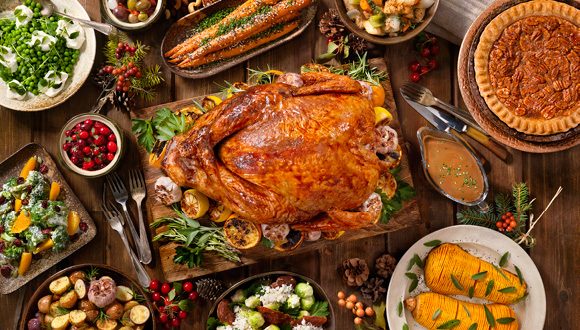The average Thanksgiving meal contains 1,000 calories. Use the following tips to help you get through Thanksgiving day feeling satisfied and energized.
Prep for the big meal
Sleep well. Getting enough sleep helps improve your impulse control with food choices and decreases cravings. The holidays tend to disrupt our sleep routine, which can set us up for unhealthy eating habits. As much as possible, try to stick to your normal sleep schedule and aim for at least 7 hours of sleep at night.
Focus on the fellowship more than the food. Remember, conversation doesn’t have calories! Enjoy time with family members and friends by having good old-fashioned fun like pulling out a board game, piecing together a puzzle or taking a trip down memory lane by looking through old photo albums.
Build your plate
Fill half your plate with colorful, non-starchy vegetables. The volume from the high water and fiber content of non-starchy vegetables will help you feel satisfied on fewer calories.
Here are a few non-starchy vegetable dishes that can serve a starring role at your Thanksgiving table:
- Roasted Brussels sprouts that naturally caramelize in the oven
- Green beans amandine (with sliced almonds)
- Honey-glazed carrots
- Arugula salad with sliced ruby-red beets
Splurge selectively on starchy sides. Thanksgiving plates tend to be loaded with starchy options. Starchy vegetables are nutrient-dense, but also higher in calories. They include:
- Butternut squash
- Corn
- Peas
- Potatoes
- Pumpkin
Choose starches wisely. Your Grandmother’s cornbread dressing? Totally worth it! An everyday dinner roll? Probably not worth the calories.
Keep portions in check by limiting starches to a quarter of your plate, and know that a single serving of starch is equal to a half cup, which looks like half of a baseball.
Grab a seat and eat
Maintain good posture. When the spinal column is straight, it opens the chest cavity and allows more oxygen uptake. Sitting up straight at the Thanksgiving table will increase your awareness of your food intake and help you to eat mindfully. In addition, good posture promotes good digestion.
Eat your turkey and non-starchy vegetables first. The protein from the turkey and the volume from the vegetables will help you feel full longer. In return, the satiety will give you greater portion control with the higher-calorie items on your plate, such as the starchy sides.
Research has shown that eating protein and vegetables before eating carbohydrates such as starches can help control blood glucose after the meal.
Eat slowly and listen to your body. Eating at a relaxed pace helps you to realize when you feel satisfied. Honoring your body’s internal fullness cues will allow you to leave the table feeling content, not uncomfortably full.
Naturally slow down your eating pace by setting down your fork between bites and savoring your food by chewing thoroughly. Or, you could even try eating with your non-dominant hand.
Here's to having the healthiest Thanksgiving ever!


